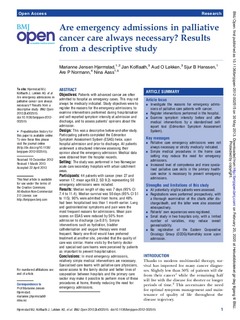| dc.contributor.author | Hjermstad, Marianne J. | |
| dc.contributor.author | Kolflaath, Jan | |
| dc.contributor.author | Løkken, Aud O. | |
| dc.contributor.author | Hanssen, Sjur B. | |
| dc.contributor.author | Normann, Are P. | |
| dc.contributor.author | Aass, Nina | |
| dc.date.accessioned | 2020-02-20T08:13:46Z | |
| dc.date.available | 2020-02-20T08:13:46Z | |
| dc.date.issued | 2013 | |
| dc.identifier.citation | Hjermstad, M.J. et al (2013): Are emergency admissions in palliative cancer care always necessary? Result from a descriptive study. BMJ Open 2013;3: e002515. | nb_NO |
| dc.identifier.uri | http://hdl.handle.net/11250/2642717 | |
| dc.description.abstract | Objectives Patients with advanced cancer are often admitted to hospital as emergency cases. This may not always be medically indicated. Study objectives were to register the reasons for the emergency admissions, to examine interventions performed during hospitalisation and self-reported symptom intensity at admission and discharge, and to assess patients’ opinions about the admission.
Design This was a descriptive before-and-after study. Participating patients completed the Edmonton Symptom Assessment System (ESAS) twice, upon hospital admission and prior to discharge. All patients underwent a structured interview assessing their opinion about the emergency admission. Medical data were obtained from the hospital records.
Setting The study was performed in two Norwegian acute care secondary hospitals with urban catchment areas.
Participants 44 patients with cancer (men 27 and women 17; mean age 69.2, SD 9.2) representing 50 emergency admissions were included.
Results Median length of stay was 7 days (95% CI 7.4 to 11.4). Median survival was 50 days (95% CI 51 to 115). 90% were admitted from home, and 46% had been hospitalised less than 1 month earlier. Lung and gastrointestinal symptoms and pain were the most frequent reasons for admissions. Mean pain scores on ESAS were reduced by 50% from admission to discharge (p<0.01). Simple interventions such as hydration, bladder catheterisation and oxygen therapy were most frequent. Nearly one-third would have preferred treatment at another site, provided that the quality of care was similar. Home visits by the family doctor and specialised care teams were perceived by patients as important to prevent hospitalisation.
Conclusions In most emergency admissions, relatively simple medical interventions are necessary. Specialised care teams with palliative care physicians, easier access to the family doctor and better lines of cooperation between hospitals and the primary care sector may make it possible to perform more of these procedures at home, thereby reducing the need for emergency admissions. | nb_NO |
| dc.publisher | BMJ Open | nb_NO |
| dc.rights | Navngivelse-Ikkekommersiell 4.0 Internasjonal | * |
| dc.rights.uri | http://creativecommons.org/licenses/by-nc/4.0/deed.no | * |
| dc.subject | emergency admissions | nb_NO |
| dc.subject | palliative cancer care | nb_NO |
| dc.subject | palliasjon | nb_NO |
| dc.subject | palliativ omsorg | nb_NO |
| dc.title | Are emergency admissions in palliative cancer care always necessary? Results from a descriptive study | nb_NO |
| dc.type | Journal article | nb_NO |
| dc.source.pagenumber | e002515 | nb_NO |
| dc.source.volume | 3 | nb_NO |
| dc.source.journal | BMJ Open | nb_NO |
| dc.source.issue | 5 | nb_NO |
| dc.identifier.doi | http://dx.doi.org/10.1136/bmjopen-2012-002515 | |

